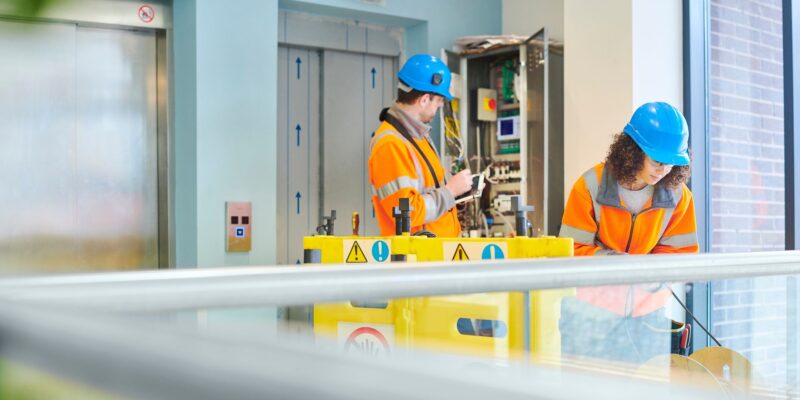Picking the most effective Lift Maintenance Contract for Long-Term Performance
Picking the most effective Lift Maintenance Contract for Long-Term Performance
Blog Article
Exploring the Comprehensive Procedures Required for Lift Maintenance
In the realm of building upkeep, making certain the appropriate functioning and security of lifts is critical. The complexity of elevator systems requires a thorough method to upkeep. From regular examinations to critical modernization strategies, an alternative sight of upkeep is essential. In the ever-evolving landscape of lift technology and security requirements, there are extensive measures that have to be thoroughly complied with to assure optimum efficiency and conformity. By dealing with vital aspects such as positive upkeep timetables, security checks, and emergency situation readiness, a complete understanding of the intricacies associated with lift maintenance can lead to improved efficiency and security.
Regular Evaluations
When it pertains to making sure the durability and security of your lift system, routine evaluations are vital. These regular checks play an important function in recognizing any type of possible issues prior to they escalate right into major issues, making sure the smooth and secure operation of the lift. By carrying out routine assessments, maintenance teams can proactively address deterioration, faulty components, or any type of other concerns that may jeopardize the lift's efficiency or security.
During these assessments, trained experts thoroughly examine numerous elements of the lift system, consisting of mechanical components, electrical systems, safety features, and overall structural stability. By spotting and attending to concerns early on, these examinations help prevent expensive repair services, downtime, or safety hazards, ultimately prolonging the life expectancy of the lift system and ensuring the wellness of its customers.
Aggressive Upkeep Schedules
Executing proactive upkeep schedules is necessary for maximizing the performance and durability of lift systems. By adhering to a proactive maintenance approach, lift proprietors can attend to prospective problems before they escalate right into major troubles, ultimately minimizing downtime and expensive repairs.
A well-structured aggressive maintenance routine ought to describe details jobs, regularities, and liable employees. When developing these timetables to ensure the lift runs securely and successfully, it is crucial to adhere to supplier recommendations and sector requirements. Furthermore, recording maintenance activities and keeping detailed documents can offer valuable insights into the lift's efficiency in time, helping in recognizing trends and making educated maintenance choices.

Safety Compliance Checks
Making certain safety compliance through extensive checks is paramount in maintaining lift systems' reliability and guarding user well-being. Safety and security compliance checks include a comprehensive assessment of different components, consisting of electrical systems, mechanical components, emergency situation brakes, doors, and various other crucial security functions. These checks are important to recognize any type of potential threats or malfunctions that could jeopardize the lift's operation and put customers in danger.
Regular safety and security conformity checks should be carried out by certified service technicians in adherence to industry guidelines and requirements. These checks assist in spotting concerns early on, enabling timely fixings and preventative maintenance measures to be applied. In addition, maintaining in-depth documents of security compliance checks is crucial for tracking the lift system's efficiency with time and showing compliance with security policies.
Equipment Upgrades and Modernization
Enhancing lift systems with devices upgrades and modernization is essential for boosting performance and safety requirements in upright transport. As innovation developments, older lift systems may become obsolete, resulting in decreased integrity and potential security risks. By buying equipment upgrades and modernization, structure owners can ensure that their lifts meet present industry requirements and policies.

Along with functional advantages, devices upgrades and innovation tasks can likewise boost the aesthetics of the lift, supplying an extra contemporary and attractive experience for travelers. Inevitably, spending in lift upgrades and modernization is a positive strategy in the direction of ensuring the durability, security, and efficiency of upright transport systems.
Emergency Preparedness Planning
An efficient emergency situation readiness strategy is essential for making sure the safety and security and quick reaction in case of unanticipated cases entailing lift systems. Emergency situation readiness planning for lift systems involves a systematic strategy to reduce risks, make sure passenger safety and security, and minimize downtime throughout emergencies.
Secret parts of an emergency situation readiness plan for lifts consist of clear communication procedures, routine training for lift operators on emergency procedures, and regular drills to examine the performance of the strategy. lift repair company. In addition, the strategy must outline specific roles and responsibilities for all stakeholders involved, consisting of structure administration, maintenance personnel, and emergency situation -responders
In case of a lift malfunction or entrapment, having a distinct emergency situation plan can aid in working with a efficient and punctual action to guarantee the safety and health of travelers. Timely interaction, access to emergency tools such as communication tools and emergency situation lighting, and expertise of emptying procedures are crucial elements of a comprehensive emergency situation preparedness strategy for lift systems. By prioritizing emergency situation preparedness preparation, structure managers can boost the general safety and dependability of their lift systems.
Conclusion
Finally, the extensive measures required for lift maintenance include normal evaluations, aggressive upkeep routines, safety and security compliance checks, tools upgrades and modernization, and emergency situation preparedness planning. These actions are vital for ensuring the security, integrity, and effectiveness of lifts in numerous settings. By implementing these procedures, lift proprietors can reduce the threat of accidents, prolong the life-span of their equipment, and follow sector regulations.

Throughout these inspections, trained experts extensively examine numerous elements of the lift system, including mechanical parts, electrical systems, safety and security features, and overall structural stability.Making certain safety compliance through detailed checks is critical in preserving lift systems' dependability and guarding customer health. Maintaining comprehensive documents of security conformity checks is critical for tracking the lift system's performance over time and demonstrating conformity with find more info safety and security guidelines.
By prioritizing emergency readiness planning, building managers can improve the overall security and reliability of their lift systems.
Report this page